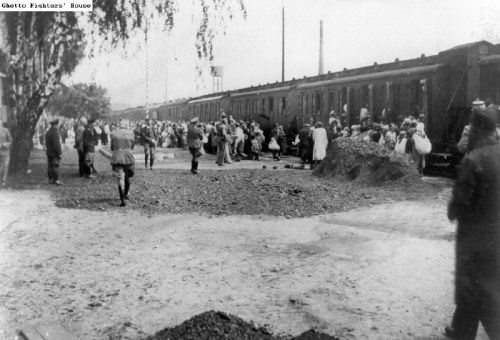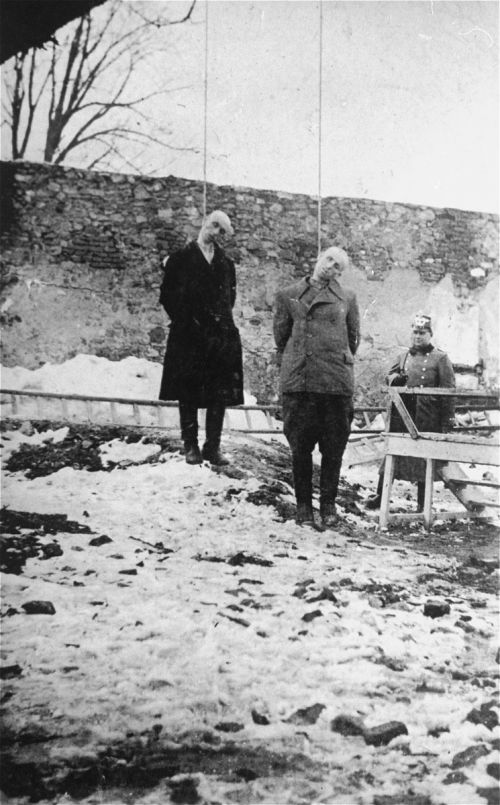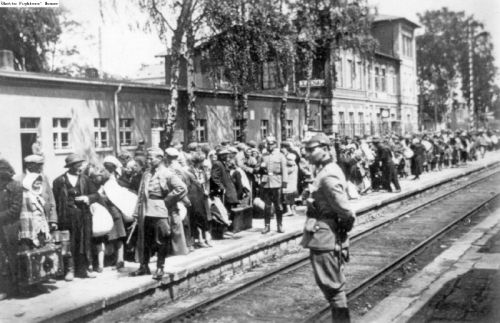Olkusz

Olkusz - Deportation of Jews (Ghetto Fighters House)
Olkusz is located approximately 25 miles east of Katowice. In 1921, there were 2,703 Jews living in Olkusz. In 1939, there were some 3,000 Jews living in the town. The German army occupied Olkusz on September 5, 1939, and from the first days of the occupation, the Jews were required to perform forced labour tasks. The Germans took as hostages the 15 most influential Jews and tortured them for several weeks.
The German authorities introduced a series of anti-Jewish measures, including the confiscation of businesses, the blocking of Jewish bank accounts, and the marking of Jewish stores. The Haupttreuhandstelle Ost was established to oversee the confiscation of Jewish and other business enterprises, as well as the selling of their assets. At the end of 1939, all Jews were required to wear white armbands, and by September 1941, they had to wear yellow patches on their left breast pockets. Also Jews were ordered to surrender all gold and silver items.
A German policeman was murdered by an unknown assailant on July 16, 1940. As a reprisal 20 Jews were publicly executed. On July 31,1940, the Nazis carried out a further reprisal that became known as 'Bloody Wednesday.' Jews were forced to lie on the ground for hours and were beaten. One Jew who could not stand the torture was shot trying to escape. Among the victims was a Jew named Majer, who was a citizen of the United States of America.

Olkusz - 2 Jews murdered by hanging (USHMM)
In May and June 1940, several hundred Jews from Bielsko-Biala, Dziedzice and Chorzow were forcibly resettled in Olkusz. The number of Jews living in Olkusz in June 1941, was 2,932. Heinrich Groll was the Kreiskommissar in Olkusz until May 1944. An officer named Flechner was the head of the Security Police in Olkusz from 1940 to 1943. He was replaced in 1943, by Kurt Eichert.
In the middle of December 1939, a Jewish Community authority (Judenrat) was established in Olkusz. The dentist Azryl Flaszenberg initially was appointed as its head, and the positions on the Judenrat were filled by the two brothers Czarniecki and a German-Jewish woman. She was appointed on the recommendation of Mojzesy Merin, the head of the Central Office of Jewish Councils in Eastern Upper Silesia. In January 1940, Merin named Dionizy Sobol as the head of the Judenrat in Olkusz.
Olkusz was one of 10 Kreis Inspectorates established by the Central Office. In October 1940, 6,156 Jews were counted in the entire Olkusz district, in German Kreis Ilkenau, and in March 1941, there were 5,940 Jews. Sobol was also head of the Kreis Inspectorate. At first, the Central Office recognised separate local branches in the towns of Olkusz - 2,940 Jews, Ogrodzieniec -43 Jews, Slawkow -843 Jews, Strzemieszyce - 1,440 Jews, and Zabkowice - 335 Jews. In July 1941, the Central Office reorganised the Kreis structure. Ogrodzieniec and Slawkow were both incorporated into the Olkusz branch, bringing the total number of Jews there to 3,825. The inspectorate also employed 100 Jewish artisans, including 39 in Olkusz.
A Jewish police force (Judischer Ordnungsdienst) was also established, and a public kitchen was created during November 1939, which accommodated the needs of observant Jews. It served approximately 300 meals a day. A kindergarten was established in December 1940, providing care for 300 children up to the age of seven.
In October 1940, the Albrecht Schmelt Organisation assumed responsibility for the labour deployment of the Jews in the region. At that time, approximately 140 Jews were sent on the first transport to work on the construction of an autobahn in Silesia (Reichsautobahn -Lager). In January 1941, a second transport of 130 people was organised, and a third transport consisting of 300 women was dispatched in August 1941. From the spring of 1942, the frequency of transports to forced labour camps increased. On March 12, 1942, 117 Jewish women aged 13 to 28 were deported from Olkusz. On April 20, 1942, 140 men were sent away. One month later on May 21-23, 1942, approximately 1,000 Jews were deported. Those Jews with some financial means could avoid the transports with bribes. By August 1942, there were 525 Jewish residents of Olkusz working at various forced labour camps.In Olkusz itself, Jews worked making suitcases in a work-shop of the Albert Rossner Company based in Bedzin. Approximately 50 people also worked in the metalworking factory of the Josef Skopek Company based in Sosnowiec.
In September 1941, the Jews of Olkusz were resettled from the centre of the town to the northern outskirts, around Parcz, Sikorki, and Slowikow Streets. The resettlement was coordinated by a special commission consisting of Germans from Sosnowiec and Bedzin. The Jews received a summons in their homes, indicating that they also had to pay for the costs of the resettlement. The operation was headed by an official of the Central Office, Kuba Wulkan, and by Bezalet Zucker, the chief representative of the Kreis Krenau Inspectorate. Also participating in the resettlement were 15 to 20 members of the Jewish Police from Bedzin and Sosnowiec, commanded by Lerhaft. Poles moved into the vacated Jewish homes in the centre of the town. The resettlement took 10 days to complete. The new Jewish residential area in Olkusz was an open ghetto. It was not surrounded by a fence or wall, but the German and Jewish police patrolled its borders, and the Jews were forbidden to leave.
The Jews suffered from overcrowded conditions, with several families sharing the same living space. Those Jews who worked in a factory producing uniforms for the German Army were issued passes to leave the ghetto each day. The Jews only received meager rations and had to stand in line for soup and bread. Coal and wood for heating were also in short supply.
On March 2, 1942, three Jews were hanged publicly in Olkusz - Jakub Mordka Glejtman, Herze Moszka Macner and Chaim Pinkus - their crimes were engaging in illegal trade. The executions took place in the presence of 200 Jews, who had been brought from the Jewish quarter to witness the execution.
The liquidation of the Olkusz ghetto was carried out on June 10, 1942. The Jews of Olkusz were gathered in the square of the local gymnasium. Initially they were led into the building of the former gymnasium for boys, which had become a kitchen area for the Jews. The gymnasium was located next to the Jewish hospital, the place where the first group and some other Jews were brought the next day. In total 3,400 Jews were gathered together. There under the supervision of SS-Obersturmbannfuhrer Friedrich Karl Kuczynski of the Organisation Schmelt and Mojzesz Merin, accompanied by other officials of the Central Council, a selection was conducted. Approximately 200 able-bodied Jews were sent at first to Sosnowiec; from there they were distributed among the labour and concentration camps in Annaberg, Blechhammer, Gross-Rosen and Buchenwald.
Approximately 200 to 300 Jews remained in Olkusz. These, probably were the workers from the workshop of Albert Rossner, along with the officials of the Judenrat, the Jewish Police, and medical personnel. The bulk of the Jews were deported to the Auschwitz Concentration Camp in two transports on June 13 and 15, 1942. Jews from nearby communities and patients from the Jewish hospital were deported along with the Jews from Olkusz. The Jewish Police assisted with the organisation and took part in the resettlement 'Aktion.'

Olkusz - Deportation of Jews- at the Railway Station (Ghetto Fighters House)
Efraim Parasol described the events:
On June 9, 1942, while the entire community was still asleep, the ghetto was surrounded by several hundred Gestapo officers and SS men. They fired incessantly and drove the entire Jewish population into the former gymnasium building. From then until June 11, it was a horrible scene. Old people, women and children were simply crammed together and suffocated from the heat and lack of oxygen. It was impossible to get even a drop of water, the shooting never stopped, people dropped like flies.
The wagons took away around 2,000 Jews, mostly elderly people and children. The dead bodies were thrown together with the living ones into the sealed wagons, which headed off to Auschwitz, directly to the crematorium.
According to the German authorities during August 1942, there were 555 Jews remaining in Olkusz. The last of the Jewish population were most likely involved in salvaging Jewish property. In March 1944, the mayor of Olkusz transferred a net sum - after deduction for unpaid taxes and personnel costs - from the liquidation of Jewish property of 114, 374 Reichsmark to the Treuhandstelle Kattowitz.
It is estimated that approximately 150 Jews from Olkusz survived at the end of the Second World War, mainly in various concentration camps and forced labour camps. In 1948, a Jewish Court of Honour in Munich condemned as a traitor to the Jewish people, a former policeman from the Olkusz ghetto, who reportedly rounded up Jews for forced labour, requisitioned Jewish furniture for the Germans, and exposed the bunkers where Jews were in hiding during the deportations.
Sources
The Encyclopaedia of Camps and Ghettos 1933-1945, USHMM, Indianna University Press Bloomington and Indianapolis 2012.
Photographs: Ghetto Fighters House Israel, USHMM Washington DC, USA.
© Holocaust Historical Society, July 18, 2020

